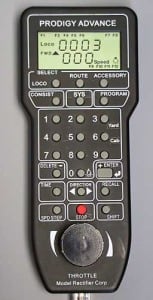Review of MRC Prodigy Advance System
by Larry Maier
MRC has released a new DCC control system named the Prodigy Advance. This system consists of three units: an AC wall transformer, the DCC Command Station, and a Cab. Installation is quick and easy. Plug the wall transformer in and connect it to the command station. Connect the cab to the command station with the included cable, and connect your track to the “Main Track” terminals. You are good to go! A second set of terminals can be connected to a separate program track if you desire.
 The Prodigy Advance is rated at 14.5 volts at the track with a rated current capability of 3.5 amperes. It can handle up to 99 cabs (may require cab bus extension with additional power) and will cover both 2-digit (1-127) and 4-digit (1-9,999) address modes. It can be set to 14/28/128 speed steps on a unit-by-unit basis, and will control up to 20 function outputs on your decoder. The Prodigy Advance supports Advanced and Universal consists, although it will only allow one Universal consist active at one time. Standard programming track operation is supported along with programming on the main. On the program track, both CV read and write are supported.
The Prodigy Advance is rated at 14.5 volts at the track with a rated current capability of 3.5 amperes. It can handle up to 99 cabs (may require cab bus extension with additional power) and will cover both 2-digit (1-127) and 4-digit (1-9,999) address modes. It can be set to 14/28/128 speed steps on a unit-by-unit basis, and will control up to 20 function outputs on your decoder. The Prodigy Advance supports Advanced and Universal consists, although it will only allow one Universal consist active at one time. Standard programming track operation is supported along with programming on the main. On the program track, both CV read and write are supported.
In today’s DCC market, most systems have the same basic features. In my mind, the two areas that distinguish one system from another are power capability and human interface. Let’s see how the Prodigy Advance stacks up in these areas. I am proceeding with the human interface first and will follow up power capability in the near future.
Human Interface
The short answer is that the MRC Prodigy Advance has one of the better (in my opinion) human interfaces on the DCC market today. I particularly like the fact that most functions are directly addressable and do not require a series of arcane button combinations to get to the function I want.
If I want to throw a switch, I hit ACCY, I enter the switch address, and then button 1 or 2 to operate the switch. Once selected, I can continuously operate the switch until I leave the selected address. On other systems I have had the problem of suddenly realizing that a switch is in the wrong direction. The train crashes before I can remember the correct sequence to change the switch. With the Prodigy Advance, the ACCY button is right there ready to operate at a moments notice. The system also has the ability to store up to 32 sets of up to 8 accessories each. This allows you to pre-store a switch route that is operated by a single button operation. If you want to access one of the switch routes, you press the ROUTE button, enter the route address (0 – 31), and activate it.
Similarly simple actions using the LOCO button or the CONSIST button allow quick access to a locomotive (or pre-established consist) or quick set-up or break down of a consist.
The MRC Prodigy Advance also keeps track of up to 25 locomotive addresses that you have used previously. These are stored in a stack that is easily accessed by the RECALL button. Each recall brings up the address of a previous engine. When you see the one you want, hit enter, and you have control! Speed control of your engine is either via a rotary knob or an increment/decrement pair of buttons, whichever feels more comfortable to you. There is also a yard mode that operates with a center off feature for situations in which the locomotive is constantly changing direction.
One minor thing I did not like about the cab is that it defaults to the 28 step speed mode at power on. If I wanted the 128-step mode, I had to set it each time I powered up the system or selected a particular locomotive.
In addition to easy to operate controls, the MRC Prodigy Advance uses a very human friendly display. Most information is displayed with an English language label that tells you what the number is or which feature is active. For example, if the locomotive is set to reverse, the legend “REV” is displayed with a backward-facing arrow. Other labeling is equally concise in allowing you to gather quickly the status of your train by a quick glance at the display.
MRC is advertising the Prodigy Advance system as so simple that the instructions fit on the back of the cab. Indeed, they are all there and can be used as a quick reminder. Further details are in the manual. To some degree, I think MRC has missed the point. It is not so much that you can print all of the directions on the back of the cab, it is that the cab is so intuitive in its operation, that most of the time, you don’t really need the directions.
